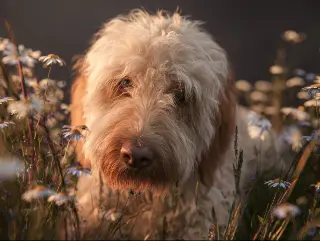Goldendoodle Breed Guide
Goldendoodles combine the sociable, eager-to-please nature of the Golden Retriever with the intelligence and low-shedding coat of the Poodle. They thrive in active households that want a friendly companion who can keep up with adventures and cuddle at the end of the day.

Goldendoodle at a Glance
| Parent breeds | Golden Retriever × Poodle (Standard, Mini, or Toy) |
|---|---|
| Common sizes | Mini 25–35 lbs, Medium 35–50 lbs, Standard 50–75 lbs |
| Coat textures | Fleece wavy, loose curl, or tight wool; low shedding but prone to mats |
| Energy level | High; 60–90 minutes of exercise plus daily training games |
| Lifespan | 12–15 years with responsible breeding |
| Ideal homes | Active families, therapy dog prospects, homes with secure yard access |
Highlights
- Highly social and people-focused; separation training is essential.
- Intelligent and food-motivated, making positive reinforcement training rewarding.
- Coat requires frequent brushing plus professional grooming every 6–8 weeks.
- Great candidates for therapy and service roles when bred for steady temperaments.
Temperament & Family Fit
Goldendoodles are affectionate, people-oriented dogs that want to be included in everything. Expect strong human focus, a desire to please, and a goofy play style inherited from the Golden Retriever side. They typically do well with respectful children and other pets when socialized from an early age.
The flip side of their sociability is a tendency toward separation anxiety if left alone for long stretches. Crate acclimation, gradual alone-time training, and providing chew enrichment help prevent destructive behaviors.
Training & Exercise Needs
Plan for structured activity every day. A mix of brisk walks, off-leash play, and brain games such as scent work or puzzle feeders keeps energy in check. Goldendoodles thrive with positive reinforcement and clear boundaries; they can become unruly if rules are inconsistent.
Because many Goldendoodles carry the retrieving gene, channel their mouthy tendencies into fetch, tug, and retrieve-to-hand games. Adolescent doodles often go through a boisterous phase—stick with short, fun training sessions to maintain focus.
Grooming Routine
Coats range from wavy fleece to tight curls. All types need thorough brushing with a slicker and metal comb three to four times weekly. Mats tend to form behind the ears, under the collar, and in armpits—work in sections down to the skin.
Schedule professional grooming every six to eight weeks for a full bath, blowout, and trim. Keep ears dry after swimming and check frequently for moisture to prevent infections.
Health Outlook
Goldendoodles benefit from mixed-breed vigor, but they still inherit risk for hip and elbow dysplasia, progressive retinal atrophy, subvalvular aortic stenosis, and certain skin issues. Ensure both parents have hip, elbow, cardiac, and eye clearances listed with OFA or equivalent databases.
Maintain a lean body condition—extra weight stresses joints and shortens lifespan. Joint supplements with omega-3s can help support mobility, especially for larger standards.
Regional Climate Considerations
Goldendoodles tolerate a wide range of weather but need extra help staying comfortable during humid summers and deep freezes.
❄️ Cold climates (great fit)
Best regions: Northern states, Rockies, New England coastal areas.
Standard coats insulate well; minis may need sweaters on long outings.
- Enjoy snow hikes with paw wax to protect from ice melt.
- Dry feathered legs and ears after play to avoid chill.
- Check paws for ice balls and trim fur between pads for traction.
- Increase calories slightly if activity ramps up in winter.
🌤️ Moderate climates (ideal)
Best regions: Great Lakes, Mid-Atlantic, Pacific Northwest.
Balanced temperatures support year-round hiking, swimming, and therapy visits.
- Keep a medium trim so coat protects skin without trapping heat.
- Schedule lengthy adventures during mild mornings and evenings.
- Rinse coats after salt water or chlorinated pool sessions.
- Brush weekly to manage seasonal undercoat changes.
🌡️ Hot & humid climates (manage closely)
Challenging regions: Gulf Coast, desert Southwest, inland Southern California.
Heat exhaustion is the biggest risk—plan activities around cooler windows.
- Exercise at dawn or dusk and test pavement temperatures before walks.
- Rotate cooling vests, shaded rest breaks, and indoor enrichment games.
- Keep coats brushed for airflow; avoid shaving to the skin to prevent sunburn.
- Offer electrolyte broths or ice cubes after vigorous play.
Living With a Goldendoodle
Provide structured downtime alongside activity so your doodle learns to settle. Use food puzzles, long-lasting chews, and snuffle mats on rainy days. Many Goldendoodles love water; introduce swimming gradually in safe environments and rinse their coat afterward.